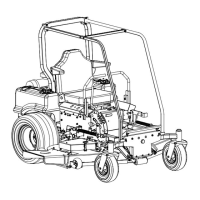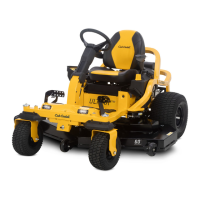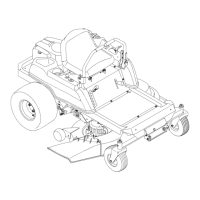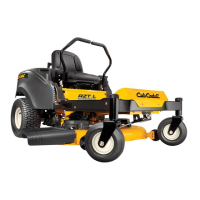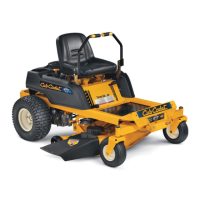
Do you have a question about the Cub Cadet RZT Zero Turn 17 and is the answer not in the manual?
| Brand | Cub Cadet |
|---|---|
| Model | RZT Zero Turn 17 |
| Category | Lawn Mower |
| Language | English |
Adjust deck pitch front to back using jam nuts on the front stabilizer bracket. Measure from blade tips.
Level deck side to side by adjusting the gear on the left side. Ensure outside blade tips are equidistant from the ground.
Steps to remove the PTO/deck belt, involving tensioner arm, idler pulleys, and clutch.
Steps to remove the deck by releasing pins, sliding forward, and lifting away.
Steps for drive belt removal, including using a breaker bar and removing from pulleys.
Remove clutch bolt and crankshaft key using specified tools for servicing the PTO clutch.
Remove the crankshaft pulley from the PTO clutch assembly.
Adjust the air gap on the clutch to specifications (0.010"-0.015") using a 9/16" socket.
Remove drive belt and rear wheel lug nuts as preparation for transmission replacement.
Disconnect the transmission bypass rod by removing the cotter pin and rod.
Disconnect lap bar control rod, brake return spring, and remove brake arm bolt.
Remove the tubular transmission brace by taking out its securing bolts.
Remove front and rear transmission mounting bolts to detach the transmission from the mounting bracket.
Confirm EZTs are neutral-adjusted; lift mower and disconnect lap bar control rod ferrules.
Loosen, rotate, and tighten the neutral return assembly to ensure wheels do not rotate at full throttle.
Secure ferrules, lower mower, test hydros, and adjust stop bolts for straight tracking.
Adjust socket head cap screws for travel stops and lap bar alignment for steering linkage.
Adjust reverse safety switch bracket if needed to ensure correct operation with lap bars.
Lift unit, disconnect battery, and remove wheel assemblies and spacers from caster bracket.
Remove axle shaft, inspect flange bearings, and apply grease during reassembly.
Remove hex cap screws securing the axle shaft to the frame for inspection or replacement.
Disconnect battery and flip seat forward, securing it to prevent movement.
Remove wing knobs, align spacers, and carefully lift the seat from the mounting bracket.
Disconnect electrical wires from the seat safety switch, ensuring proper reconnection for operation.
Identify components attached to left and right consoles, including switches, relays, and levers.
Disconnect battery and remove screws securing console to seat frame and tubular frame.
Remove lapbar pivot bracket screw, lapbar, and carefully lift the console from the unit.
Disconnect battery leads and remove the battery strap from the frame.
Remove fuel pump screws and extract the battery by pulling it up and to the side.
Remove the right side console to gain access for battery removal.
Disconnect battery leads, strap, and remove console to easily slide battery out.
Perform seat and battery removal sections before proceeding with fuel tank removal.
Remove fuel tank mounting wire and disconnect the electrical connector for tank removal.
Remove left console, rotate fuel tank, disconnect fuel line, and remove the tank.
Disconnect battery, remove side console, and disconnect ferrule from neutral assembly.
Remove hex cap screw, flat washer, and hairpin to detach control hub and lapbar rod.
Disconnect lapbar control rod, remove control hub, and remove outboard hex flange bearing.
Remove the control shaft from under the seat frame and inspect bearings and shaft for wear.
Perform Deck Removal, Seat Removal, Console Removal, and Battery Removal sections first.
Disconnect fuel tank connections and remove screws holding the seat box frame.
Disconnect lapbar control rods from the return to neutral brackets as part of deck lift shaft removal.
Remove brake handle components and hairpins securing deck lift cables.
Slide concentric shaft, remove brake rods, and remove the rubber handle from the deck lift rod.
Release tension on torsion spring and remove E-clips from the deck lift shaft ends.
Remove hex flange bearings, position frame, and shuffle assembly out of the seat box.
Location and function of the seat safety switch, normally closed contacts.
Location and function of the parking brake switch, normally open contacts.
Location and function of console-mounted neutral switches (N.O./N.C. contacts).
Location and function of lapbar-mounted reverse switches (N.C. contacts).
Location and function of the PTO switch, part of start, PTO run, and reverse safety circuits.
Location and function of the key switch, noting midyear changes and testing procedures.
Details on seat, PTO, and brake relays, their locations, and activation criteria.
Location and importance of a good ground path for the starter solenoid.
